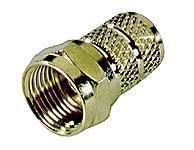F Connector
The F connector is a particular type of radio frequency connector that was developed in the early 1950’s. Eric Winston is usually credited with the creation of the F connector, while developing cable television as an alternative to the broadcast television options of the day.
What does the F Connector do?
The F connector provides an inexpensive connection for coaxial cables to communications devices and to other cables. While the cost of an F connector is generally less than many other types of radio frequency cable connectors, the connection provided by the F connector is often stable. Because the F connector employs a center wire method of construction, the connector is slightly more subject to corrosion and damage than some other forms of radio frequency connectors. Still, adequate care and maintenance can allow an F connector to last for a number of years.
Sizes Available with F Connectors
The F connector allows for a solid 75 ohm impedance with a match of up to 1 GHz. This places the F connector squarely in the middle of the expected performance of most of the different types of radio frequency connectors on the market today. Female connectors typically have a 3/8-3 thread diameter, while male connectors are slightly smaller. Some of the newer versions of the F connector use a push and pull design, even though they generally considered to provide less shielding efficiency than the screw on varieties of the F connector.
How can an F Connector be Used?
F connectors have been around for a number of years, and have been a common component with broadcast television equipment. Along with broadcast television, the F connector is also often found in use with cable television equipment. The RF connected is used almost universally with satellite transmissions, especially satellite television.


Comments - One Response to “F Connector”
Sorry but comments are closed at this time.